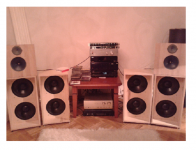grim,
here is another idea for you;
why don't you try to stack your h frames vertically like a bass array?
you may put the MT unit on a neat speaker stand on its own.
i have a feeling they would sound and look better.
here is another idea for you;
why don't you try to stack your h frames vertically like a bass array?
you may put the MT unit on a neat speaker stand on its own.
i have a feeling they would sound and look better.
What do you think?
BTW. Thanks for the help!
tried to place all on their side horisontal, forming a 'curve' ?
Attachments
There is a lot to gain in efficiency by stacking the H-frames on top of each other, especially at very low frequencies.
Two main reasons I think
1. Some room boundary coupling to the ceiling.
2. The path length in the vertical plane is doubled, in this case 2 times the max path length is stacked side-by-side.
I measured 16 dB gain at 20 Hz in my setup then I put an additional H-baffle on top of an other. 6 dB from twice as much cone area, and 10 dB from better acoustic efficiency.
1. Some room boundary coupling to the ceiling.
2. The path length in the vertical plane is doubled, in this case 2 times the max path length is stacked side-by-side.
I measured 16 dB gain at 20 Hz in my setup then I put an additional H-baffle on top of an other. 6 dB from twice as much cone area, and 10 dB from better acoustic efficiency.
I understand
16db measure gain, when stacked compare to single, and double driver compared to single
did you also measure same quantity drivers placed side by side, compared to stacked ?
or I dont understand
 😀
😀
16db measure gain, when stacked compare to single, and double driver compared to single
did you also measure same quantity drivers placed side by side, compared to stacked ?
or I dont understand

 😀
😀Yes, I measured side-by-side on the floor as well. This only resulted in the expected 6 dB gain.
ok, thanks
I remember now that line source/array is supposed to have consistent output level/SPL independent on distance, where 'regular' setup SPL depend on distance
I remember now that line source/array is supposed to have consistent output level/SPL independent on distance, where 'regular' setup SPL depend on distance
could be because the line array have narrow dispersion, so that in 'OB', the dipole pattern becomes 'longer', more streched out
might be that it sounds more 'directive' like monopole
might be that it sounds more 'directive' like monopole
The line is not long enough (typically 2 meters) at 20 Hz, where the wave length is 17 meters. I think the explanation for the increase in efficiency has to be found elsewhere.
...explanation for the increase in efficiency has to be found elsewhere.
but a line array arrangement still has the effect that dispersion is limited to being only horisontal... ?
Yes, that is true. But to remain a true line source, the length (or height in reality..) must be several times the wavelength, in reality around 4 times. For 20 Hz that means a line 68 meters in length.
An example: my RD-75 ribbons are true line-source with almost no vertical dispersion only above 6-700 Hz. And they are 2 meters tall.
An example: my RD-75 ribbons are true line-source with almost no vertical dispersion only above 6-700 Hz. And they are 2 meters tall.
No, not if you couple to the ceiling. Then it is effectively infinate. Excluding the other room effects.
Additionoally, as might have been mentioned by tinitus, your spl drop with distance will be 1/2 or 3db not 6db as in a point source loss/distance.
Additionoally, as might have been mentioned by tinitus, your spl drop with distance will be 1/2 or 3db not 6db as in a point source loss/distance.
At 20 Hz in a room of any "small" size there is nothing like sound propagation - it's solely excitation of modes. Could it be that a velocity transducer works more efficiently in the middle of the room than along any borders?
No, not if you couple to the ceiling. Then it is effectively infinate. Excluding the other room effects.
Yes of course. And that's why floor-to-ceiling woofer towers gain so much in efficiency.
At 20 Hz ....
its just a figure for measurements 🙄
but if its the same at 30hz it might even be audible 😀
its just a figure for measurements 🙄
but if its the same at 30hz it might even be audible 😀
10 dB at 30 Hz is indeed audible. The Phon curves are closer at low frequencies, making a 10 dB increase subjectively greater at 30 Hz than at 1 kHz.
An externally hosted image should be here but it was not working when we last tested it.
- Status
- Not open for further replies.
- Home
- Loudspeakers
- Multi-Way
- Precision Devices PD.2450 in OB, or alternatives ?
